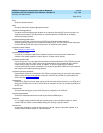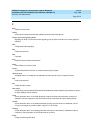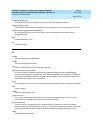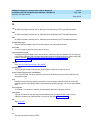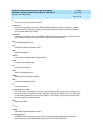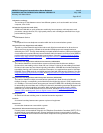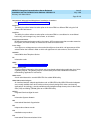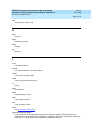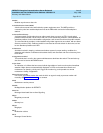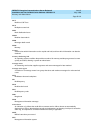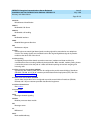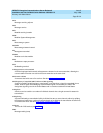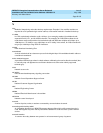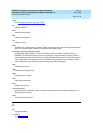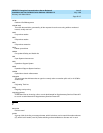
DEFINITY Enterprise Communications Server Release 6
Installation and Test for Multi-Carrier Cabinets
555-230-112
Issue 5
May 1998
Glossary and Abbreviations
Page GL-30
lightwave transceiver
Hardware that provides an interface to fiber-optic cable from port circuit packs and DS1 converter
circuit packs. Lightwave transceivers convert electrical signals to light signals and vice versa.
line
A transmission path between a communications system or CO switching system and a voice
terminal or other terminal.
line appearance
See appearance
.
line buildout
A selectable output attenuation is generally required of DTE equipment because T1 circuits
require the last span to lose 15–22.5 dB.
line port
Hardware that provides the access point to a communications system for each circuit associated
with a telephone or data terminal.
link
A transmitter-receiver channel that connects two systems.
link-access procedure on the D-channel (LAPD)
A link-layer protocol on the ISDN-BRI and ISDN-PRI data-link layer (level 2). LAPD provides data
transfer between two devices, and error and flow control on multiple logical links. LAPD is used for
signaling and low-speed packet data (X.25 and mode 3) on the signaling (D-) channel and for
mode-3 data communications on a bearer (B-) channel.
LINL
Local indirect neighbor link
local area network (LAN)
A networking arrangement designed for a limited geographical area. Generally, a LAN is limited in
range to a maximum of 6.2 miles and provides high-speed carrier service with low error rates.
Common configurations include daisy chain, star (including circuit-switched), ring, and bus.
logical link
The communications path between a processor and a BRI terminal.
loop-start trunk
A trunk on which, after establishing a connection with a distant switching system for an outgoing
call, the system waits for a signal on the loop formed by the trunk leads before sending the digits
of the called number.
LSU
Local storage unit
LWC
Leave Word Calling
M
MAC
Medium access



